The remote lockout tool market stands at the threshold of a decade-long expansion trajectory that promises to reshape industrial safety technology and lockout/tagout solutions. The market's journey from USD 900.0 million in 2025 to USD 1,494.2 million by 2035 represents substantial growth, demonstrating the accelerating adoption of advanced safety technology and industrial automation across manufacturing facilities, utilities operations, and oil & gas applications.
The first half of the decade (2025 to 2030) will witness the market climbing from USD 900.0 million to approximately USD 1,172.5 million, adding USD 272.5 million in value, which constitutes 46% of the total forecast growth period. This phase will be characterized by the rapid adoption of smart padlocks/hasps systems, driven by increasing industrial safety requirements and the growing need for advanced lockout/tagout solutions worldwide. Enhanced connectivity capabilities and automated safety systems will become standard expectations rather than premium options.
The latter half (2030 to 2035) will witness continued growth from USD 1,172.5 million to USD 1,494.2 million, representing an addition of USD 321.7 million or 54% of the decade's expansion. This period will be defined by mass market penetration of advanced remote lockout technologies, integration with comprehensive industrial safety platforms, and seamless compatibility with existing manufacturing infrastructure. The market trajectory signals fundamental shifts in how industrial facilities approach safety management and compliance assurance, with participants positioned to benefit from growing demand across multiple solution types and application segments.
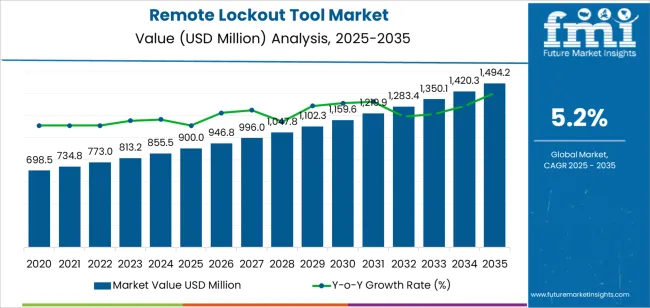
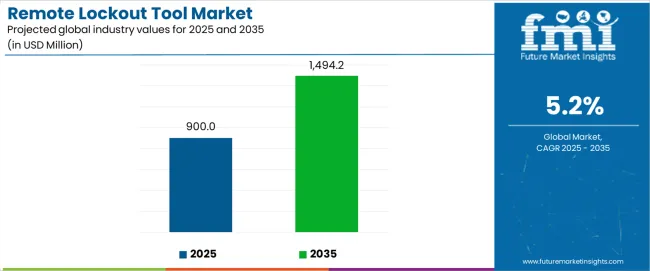
| Period | Primary Revenue Buckets | Share | Notes |
|---|---|---|---|
| Today | Smart padlocks/hasps | 30% | Volume-driven, safety applications |
| Remote LOTO controllers | 28% | Control focus, automation systems | |
| Circuit/PLC lockouts | 22% | Technical applications, electrical safety | |
| Valve/actuator lockouts | 20% | Industrial focus, process safety | |
| Future (3-5 yrs) | Advanced smart systems | 28-32% | Technology enhancement, connectivity optimization |
| Intelligent controllers | 26-30% | Automation improvement, remote monitoring | |
| Enhanced circuit solutions | 20-24% | Electrical safety, compliance positioning | |
| Smart valve systems | 18-22% | Process applications, industrial automation |
| Metric | Value |
|---|---|
| Market Value (2025) | USD 900.0 million |
| Market Forecast (2035) | USD 1,494.2 million |
| Growth Rate | 5.2% CAGR |
| Leading Product | Smart Padlocks/Hasps |
| Primary Application | Manufacturing Segment |
The market demonstrates strong fundamentals with smart padlocks/hasps capturing a dominant 30.0% share through advanced safety capabilities and connectivity optimization. Manufacturing applications drive primary demand with 38.0% market share, supported by increasing industrial safety requirements and compliance programs. Geographic expansion remains concentrated in developed markets with established industrial infrastructure, while emerging economies show accelerating adoption rates driven by safety initiatives and rising compliance standards.
Primary Classification: The market segments by solution type into smart padlocks/hasps, remote LOTO controllers, circuit/PLC lockouts, and valve/actuator lockout variants, representing the evolution from basic safety tools to specialized industrial solutions for comprehensive lockout/tagout and safety optimization.
Secondary Classification: Connectivity segmentation divides the market into cellular (LTE/5G) (28.0%), bluetooth/NFC (25.0%), offline/standalone (25.0%), and Wi-Fi (22.0%) categories, reflecting distinct requirements for communication capabilities, remote monitoring standards, and connectivity performance.
End Use Classification: End use segmentation covers manufacturing (38.0%), oil & gas/chemicals (25.0%), utilities (22.0%), and facilities/other (15.0%) sectors, addressing different safety requirements from industrial operations to specialized facility applications.
Compliance Program Classification: Compliance segmentation addresses OSHA-driven (40.0%), ISO/EN (30.0%), dual compliance (20.0%), and custom programs (10.0%) categories, reflecting different regulatory requirements and safety standardization needs.
The segmentation structure reveals technology progression from standard safety tools toward specialized industrial systems with enhanced connectivity consistency and compliance capabilities, while application diversity spans from manufacturing to utilities requiring precise safety solutions.
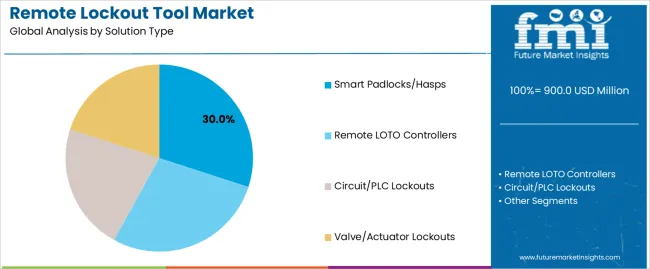
Market Position: Smart padlocks/hasps systems command the leading position in the remote lockout tool market with 30.0% market share through advanced safety characteristics, including superior connectivity performance, durability optimization, and industrial compatibility that enable safety managers to achieve optimal protection across diverse manufacturing and industrial applications.
Value Drivers: The segment benefits from safety manager preference for reliable lockout systems that provide consistent security performance, reduced complexity, and compliance optimization without requiring significant infrastructure modifications. Advanced connectivity features enable automated monitoring systems, access control, and integration with existing safety equipment, where operational performance and regulatory compliance represent critical safety requirements.
Competitive Advantages: Smart padlocks/hasps systems differentiate through proven safety reliability, consistent security characteristics, and integration with automated industrial systems that enhance safety effectiveness while maintaining optimal compliance standards for diverse manufacturing and process applications.
Key market characteristics:
Remote LOTO controllers maintain a 28.0% market position in the remote lockout tool market due to their proven control capabilities and centralized management characteristics. These systems appeal to facilities requiring comprehensive safety management with targeted positioning for complex industrial and automated applications. Market growth is driven by automation segment expansion, emphasizing reliable control solutions and safety optimization through proven technologies.
Circuit/PLC lockouts account for 22.0% market share, serving electrical safety applications requiring specialized lockout performance and technical safety characteristics for complex industrial requirements.
Valve/actuator lockouts capture 20.0% market share, focusing on process safety applications, industrial valves, and operations requiring efficient lockout solutions for process optimization and safety enhancement.
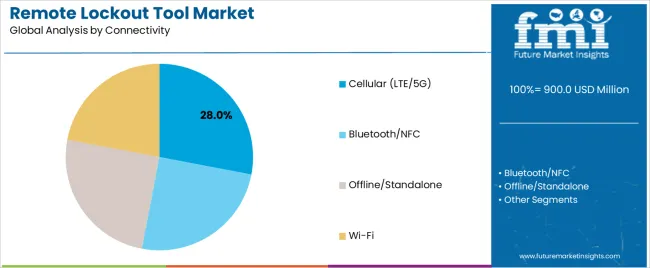
Market Context: Cellular (LTE/5G) connectivity applications demonstrate market leadership in the remote lockout tool market with 28.0% share due to widespread adoption of wireless communication systems and increasing focus on remote monitoring, operational efficiency, and connectivity enhancement that maximize safety performance while maintaining communication standards.
Appeal Factors: Safety managers prioritize cellular connectivity, communication efficiency, and integration with existing monitoring infrastructure that enables coordinated safety operations across multiple industrial systems. The segment benefits from substantial industrial investment and modernization programs that emphasize the acquisition of advanced wireless systems for safety optimization and remote monitoring applications.
Growth Drivers: Industrial programs incorporate cellular connectivity as standard components for safety operations, while automation development growth increases demand for consistent wireless capabilities that comply with communication standards and minimize operational costs.
Application dynamics include:
Bluetooth/NFC and offline/standalone connectivity applications each capture 25.0% market share through comprehensive communication requirements in specialized safety projects, local monitoring operations, and proximity-based safety applications. These applications demand reliable connectivity systems capable of operating in diverse environments while providing effective communication integration and performance capabilities.
Wi-Fi connectivity applications account for 22.0% market share, including network-based operations, facility-wide systems, and applications requiring efficient wireless solutions for safety optimization and communication enhancement.
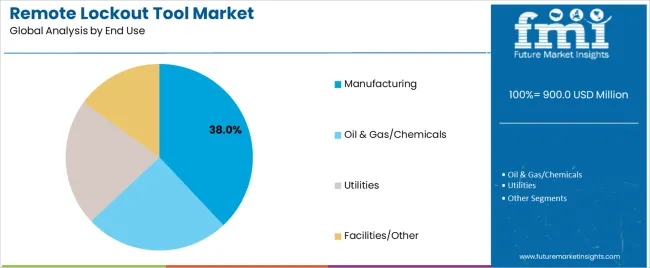
The manufacturing segment commands 38.0% market share through widespread adoption in industrial production applications, factory operations, and manufacturing projects. These operations provide advanced safety solutions for complex production requirements while maintaining operational flexibility and compliance reliability.
Oil & gas/chemicals applications capture 25.0% market share, serving process industries, chemical plants, and facilities requiring enhanced safety capabilities for hazardous operation optimization and risk management.
Utilities applications account for 22.0% market share, addressing power generation requirements, utility operations, and infrastructure requiring specialized safety capabilities for operational optimization.
Facilities/other applications capture 15.0% market share, including commercial buildings, institutional facilities, and operations requiring unique safety capabilities for compliance enhancement.
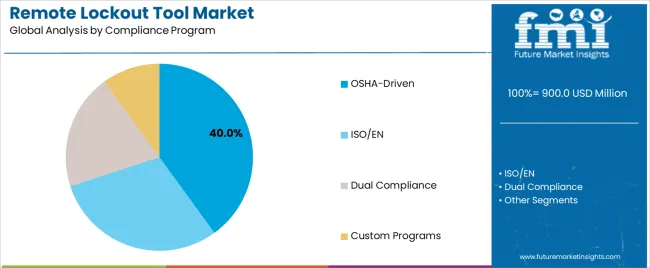
The OSHA-driven segment commands 40.0% market share through widespread adoption in US industrial applications, federal compliance operations, and safety projects requiring OSHA standard adherence for regulatory optimization and workplace safety.
ISO/EN compliance applications capture 30.0% market share, serving international standards, European regulations, and global facilities requiring enhanced compliance capabilities for international operation optimization.
Dual compliance applications account for 20.0% market share, while custom programs capture 10.0% market share, addressing specialized regulatory requirements and customized safety applications requiring unique compliance capabilities for operation optimization.
| Category | Factor | Impact | Why It Matters |
|---|---|---|---|
| Driver | Industrial safety regulations & compliance requirements (OSHA standards, workplace safety mandates) | ★★★★★ | Large-scale safety initiatives require efficient, high-performance lockout solutions with consistent quality and compliance integration across industrial applications. |
| Driver | Industrial automation growth & smart manufacturing (Industry 4.0, IoT integration) | ★★★★★ | Drives demand for efficient safety solutions and automation-compliant capabilities; suppliers providing connectivity features gain competitive advantage. |
| Driver | Workplace safety awareness & accident prevention (risk management, liability reduction) | ★★★★☆ | Industrial operators need advanced, reliable safety solutions; demand for innovative protection features expanding addressable market segments. |
| Restraint | High technology costs & implementation complexity | ★★★★☆ | Small manufacturers face cost pressure; increases price sensitivity and affects adoption in cost-sensitive segments with limited safety budgets. |
| Restraint | Integration challenges & legacy system compatibility | ★★★☆☆ | Safety-focused operations face challenges with system integration and specialized implementation requirements, limiting adoption in resource-constrained segments. |
| Trend | Smart safety integration & predictive maintenance | ★★★★★ | Growing demand for intelligent safety solutions; predictive capabilities become core value proposition in advanced industrial segments. |
| Trend | Wireless connectivity expansion & remote monitoring | ★★★★☆ | Regional development drives demand for connected safety solutions; communication capabilities drive competition toward digitalization. |
The remote lockout tool market demonstrates varied regional dynamics with growth leaders including China (6.4% growth rate) and Brazil (6.0% growth rate) driving expansion through industrial modernization and safety compliance development. Strong Performers encompass USA (4.9% growth rate), UK (4.9% growth rate), and Germany (4.8% growth rate), benefiting from established industrial safety standards and advanced lockout adoption. Mature Markets feature South Korea (4.4% growth rate) and Japan (3.7% growth rate), where industrial safety development and compliance standardization requirements support consistent growth patterns.
Regional synthesis reveals Asian markets leading adoption through industrial automation expansion and safety modernization development, while Western countries maintain steady expansion supported by compliance advancement and regulatory requirements. Emerging markets show strong growth driven by industrial safety applications and automation integration trends.
| Region/Country | 2025 to 2035 Growth | How to win | What to watch out |
|---|---|---|---|
| China | 6.4% | Focus on automation-ready safety solutions | Regulatory complexity; local competition |
| Brazil | 6.0% | Lead with cost-effective compliance models | Economic dependencies; infrastructure limitations |
| USA | 4.9% | Value-oriented OSHA compliance models | Market maturity; regulatory changes |
| UK | 4.9% | Offer premium safety systems | Market maturity; compliance regulations |
| Germany | 4.8% | Provide advanced industrial integration | Over-engineering; regulatory compliance |
| South Korea | 4.4% | Push industrial automation applications | Technology costs; domestic competition |
| Japan | 3.7% | Premium quality positioning | Market maturity; precision requirements |
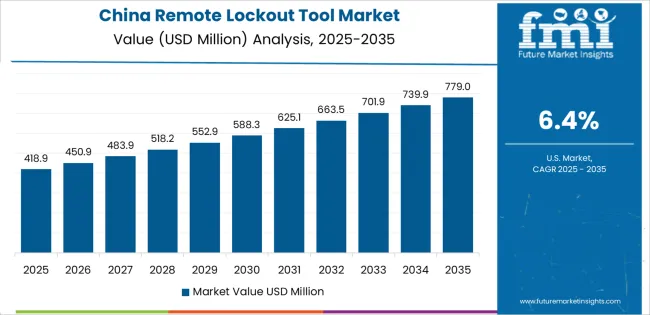
China establishes fastest market growth through aggressive industrial modernization programs and comprehensive safety compliance development, integrating advanced remote lockout tool systems as standard components in manufacturing facilities, industrial automation, and safety applications. The country's 6.4% growth rate reflects government initiatives promoting industrial safety and automation development capabilities that mandate the use of advanced safety systems in industrial projects. Growth concentrates in major industrial centers, including Guangdong, Jiangsu, and Zhejiang, where industrial technology development showcases integrated remote lockout systems that appeal to manufacturers seeking advanced safety optimization capabilities and compliance management applications.
Chinese manufacturers are developing automation-focused remote lockout solutions that combine domestic manufacturing advantages with advanced safety features, including IoT connectivity systems and enhanced monitoring capabilities. Distribution channels through industrial suppliers and safety service distributors expand market access, while government support for industrial development supports adoption across diverse manufacturing segments.
Strategic Market Indicators:
Remote lockout tool market expansion in Brazil benefits from diverse industrial development demand, including manufacturing growth in São Paulo and Rio de Janeiro, industrial safety upgrades, and compliance programs that increasingly incorporate remote lockout systems for safety optimization applications. The country maintains a 6.0% growth rate, driven by rising safety consciousness and increasing recognition of advanced lockout benefits, including enhanced industrial performance and improved compliance functionality.
Market dynamics focus on cost-effective remote lockout solutions that balance advanced safety performance with affordability considerations important to Brazilian industrial operators. Growing industrial safety development creates continued demand for lockout systems in manufacturing infrastructure and compliance enhancement projects.
Strategic Market Indicators:
United States establishes advanced safety integration through comprehensive industrial modernization and technology development, integrating remote lockout tool systems across manufacturing facilities and industrial operations. The country's 4.9% growth rate reflects mature industrial relationships and established safety adoption that supports widespread use of lockout systems in manufacturing and process facilities. Growth concentrates in major industrial centers, including Texas, California, and the Midwest, where industrial technology showcases mature remote lockout deployment that appeals to operators seeking proven safety capabilities and compliance efficiency applications.
American manufacturers leverage established distribution networks and comprehensive industrial safety capabilities, including system integration programs and technical support that create customer relationships and operational advantages. The market benefits from mature OSHA standards and safety requirements that mandate lockout system use while supporting technology advancement and compliance optimization.
Strategic Market Indicators:
United Kingdom establishes safety development through comprehensive industrial modernization and compliance integration, integrating remote lockout systems across manufacturing and specialty industrial applications. The country's 4.9% growth rate reflects growing safety investment and increasing adoption of lockout technology that supports expanding use of advanced systems in British industrial facilities. Growth concentrates in major regions, including North West, Yorkshire, and West Midlands, where industrial technology development showcases integrated remote lockout systems that appeal to British operators seeking advanced safety solutions with compliance compatibility.
British manufacturers focus on maintaining quality standards while adopting industrial safety efficiency, creating demand for systems that balance performance with operational advantages. The market benefits from strong industrial infrastructure and growing safety consciousness that support lockout technology adoption while maintaining quality standards important to British industrial applications.
Strategic Market Indicators:
Advanced industrial technology market in Germany demonstrates sophisticated remote lockout tool system deployment with documented operational effectiveness in manufacturing applications and industrial safety projects through integration with existing automation systems and production infrastructure. The country leverages engineering expertise in safety technology and industrial systems integration to maintain a 4.8% growth rate. Industrial centers, including North Rhine-Westphalia, Bavaria, and Baden-Württemberg, showcase premium installations where remote lockout systems integrate with comprehensive industrial platforms and safety management systems to optimize production operations and compliance effectiveness.
German manufacturers prioritize system precision and EU compliance in safety development, creating demand for premium systems with advanced features, including safety monitoring integration and automated lockout systems. The market benefits from established industrial technology infrastructure and willingness to invest in advanced safety technologies that provide long-term operational benefits and compliance with international industrial standards.
Strategic Market Indicators:
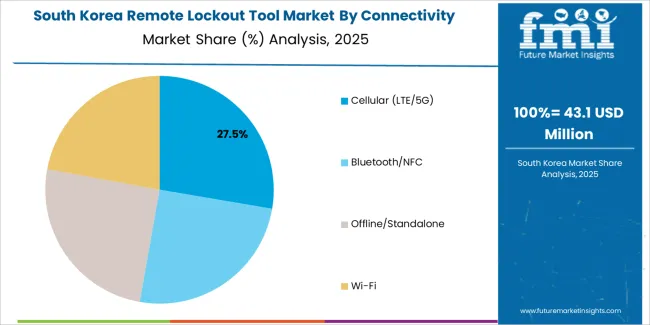
South Korea establishes industrial innovation development through comprehensive automation modernization and technology integration, integrating remote lockout systems across manufacturing processing and specialty industrial applications. The country's 4.4% growth rate reflects growing innovation investment and increasing adoption of safety technology that supports expanding use of advanced systems in Korean industrial facilities. Growth concentrates in major industrial areas, including Gyeonggi, South Chungcheong, and Ulsan, where industrial technology development showcases integrated remote lockout systems that appeal to Korean operators seeking advanced safety solutions with automation compatibility.
Korean manufacturers focus on maintaining quality standards while adopting industrial automation, creating demand for systems that balance performance with technological advantages. The market benefits from strong industrial infrastructure and growing export opportunities that support lockout technology adoption while maintaining quality standards important to Korean industrial applications.
Strategic Market Indicators:
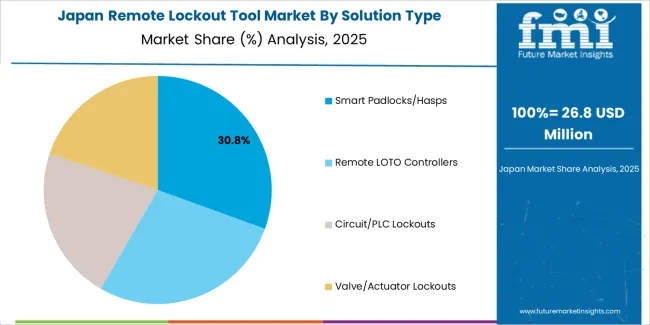
Advanced industrial technology market in Japan demonstrates sophisticated remote lockout tool system deployment with documented operational effectiveness in premium manufacturing applications and specialized industrial projects through integration with existing quality systems and production infrastructure. The country maintains a 3.7% growth rate, leveraging traditional quality expertise and precision systems integration in safety technology. Industrial centers, including Tokyo, Osaka, and Nagoya, showcase premium installations where remote lockout systems integrate with traditional quality platforms and modern production management systems to optimize industrial operations and maintain safety quality profiles.
Japanese manufacturers prioritize industrial precision and quality consistency in safety development, creating demand for premium systems with advanced features, including quality monitoring and automated industrial systems. The market benefits from established quality infrastructure and commitment to industrial standards that provide long-term operational benefits and compliance with traditional quality manufacturing methods.
Strategic Market Indicators:
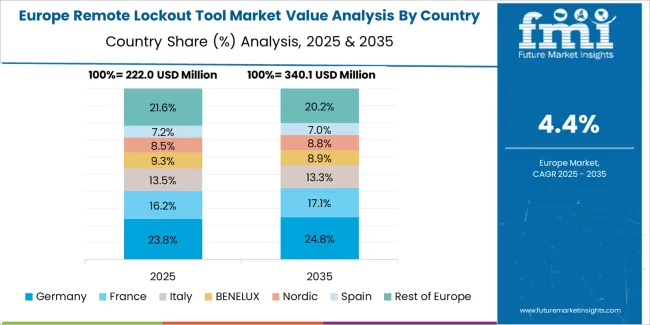
The remote lockout tool market in Europe is projected to grow from USD 270.0 million in 2025 to USD 418.0 million by 2035, registering a CAGR of 4.5% over the forecast period. Germany is expected to maintain its leadership position with a 31.8% market share in 2025, growing to 32.4% by 2035, supported by its advanced industrial infrastructure and major manufacturing centers including North Rhine-Westphalia and Bavaria.
United Kingdom follows with a 24.2% share in 2025, projected to reach 24.6% by 2035, driven by comprehensive industrial safety programs and lockout innovation development. France holds a 18.5% share in 2025, expected to maintain 18.2% by 2035 despite market adjustments. Italy commands a 13.7% share, while Netherlands accounts for 11.8% in 2025. The Rest of Europe region is anticipated to gain momentum, maintaining its collective share at approximately 11.5% by 2035, attributed to increasing remote lockout adoption in Nordic countries and emerging industrial facilities implementing safety-focused programs.
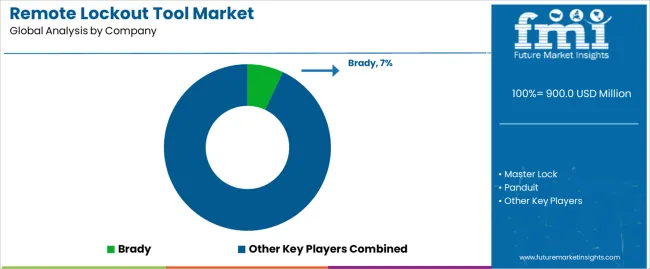
| Stakeholder | What they actually control | Typical strengths | Typical blind spots |
|---|---|---|---|
| Global platforms | Safety reach, deep industrial catalogs, manufacturing facilities | Broad availability, proven reliability, multi-region projects | Technology refresh cycles; application dependency management |
| Technology innovators | R&D capabilities; advanced safety systems; connectivity interfaces | Latest technology first; attractive ROI on large projects | Service density outside core regions; customization complexity |
| Regional specialists | Local sourcing, fast delivery, nearby safety support | "Close to site" support; pragmatic pricing; local safety codes | Technology gaps; talent retention in safety engineering |
| Quality-focused ecosystems | Safety consistency, technical support, compliance sourcing | Lowest performance variation; comprehensive support | Implementation costs if overpromised; technology obsolescence |
| Application specialists | Specialized configurations, custom solutions, industrial development | Win specialized projects; flexible engineering | Scalability limitations; narrow market focus |
| Items | Values |
|---|---|
| Quantitative Units (2025) | USD 900.0 million |
| Solution Type | Remote LOTO Controllers, Smart Padlocks/Hasps, Circuit/PLC Lockouts, Valve/Actuator Lockouts |
| Connectivity | Bluetooth/NFC, Wi-Fi, Cellular (LTE/5G), Offline/Standalone |
| End Use | Manufacturing, Utilities, Oil & Gas/Chemicals, Facilities/Other |
| Compliance Program | OSHA-Driven, ISO/EN, Dual Compliance, Custom Programs |
| Regions Covered | North America, Europe, Asia Pacific, South America, Middle East & Africa |
| Countries Covered | USA, Germany, China, United Kingdom, Japan, South Korea, Brazil, and 25+ additional countries |
| Key Companies Profiled | Brady, Master Lock, Panduit, ABUS, Emerson, Rockwell Automation, Honeywell, IDEAL Industries, Hubbell |
| Additional Attributes | Dollar sales by solution type and connectivity categories, regional adoption trends across North America, Europe, and Asia Pacific, competitive landscape with safety manufacturers and industrial suppliers, operator preferences for safety consistency and compliance reliability, integration with industrial platforms and safety management systems, innovations in remote lockout technology and industrial enhancement, and development of advanced safety solutions with enhanced performance and compliance optimization capabilities. |
The global remote lockout tool market is estimated to be valued at USD 900.0 million in 2025.
The market size for the remote lockout tool market is projected to reach USD 1,494.2 million by 2035.
The remote lockout tool market is expected to grow at a 5.2% CAGR between 2025 and 2035.
The key product types in remote lockout tool market are smart padlocks/hasps, remote loto controllers, circuit/plc lockouts and valve/actuator lockouts.
In terms of connectivity, cellular (lte/5g) segment to command 28.0% share in the remote lockout tool market in 2025.






Full Research Suite comprises of:
Market outlook & trends analysis
Interviews & case studies
Strategic recommendations
Vendor profiles & capabilities analysis
5-year forecasts
8 regions and 60+ country-level data splits
Market segment data splits
12 months of continuous data updates
DELIVERED AS:
PDF EXCEL ONLINE
Remote Desktop Software Market Forecast and Outlook 2025 to 2035
Remote Patient Monitoring Devices Market Size and Share Forecast Outlook 2025 to 2035
Remote Assist Headrest Market Size and Share Forecast Outlook 2025 to 2035
Remote Endarterectomy Devices Market Size and Share Forecast Outlook 2025 to 2035
Remote Electrocardiogram Monitoring Market Size and Share Forecast Outlook 2025 to 2035
Remote Valve Tissue Expanders Market Size and Share Forecast Outlook 2025 to 2035
Remote Patient Monitoring System Market Size and Share Forecast Outlook 2025 to 2035
Remote Imaging Collaboration Market Analysis - Size, Share, and Forecast Outlook 2025 to 2035
Remote Operated Vehicle Market Size and Share Forecast Outlook 2025 to 2035
Remote DC Microgrid Market Size and Share Forecast Outlook 2025 to 2035
Remote Microgrid Market Size and Share Forecast Outlook 2025 to 2035
Remote Towers Market Size and Share Forecast Outlook 2025 to 2035
Remote Vehicle Diagnostics Market Size and Share Forecast Outlook 2025 to 2035
Remote Home Monitoring Systems Market Size and Share Forecast Outlook 2025 to 2035
Remote Asset Management Market Size and Share Forecast Outlook 2025 to 2035
Remote Learning Technology Spending Market Analysis by Technology Software, Technology Services, Learning Mode, End User and Region Through 2025 to 2035
Remote Sensing Services Market Trends - Growth & Forecast 2025 to 2035
Remote Cooled Cube Ice Machines Market – Advanced Refrigeration & Industry Growth 2025 to 2035
Remote Healthcare Market - Growth & Innovations 2025 to 2035
Remote Construction Market Analysis by Component, Application, End-use Industry and Region Through 2035

Thank you!
You will receive an email from our Business Development Manager. Please be sure to check your SPAM/JUNK folder too.
Chat With
MaRIA